Weekend Trip - Day 2 - Cabo Villano - Laxe - Punta Roncudo - Malpica
05/11/06 18:32 Filed in: Galicia
First stop today is Cabo Villano which was the first land sighted when I crossed from Plymouth to Lisbon some years ago. The area is a bit more built up than Finisterre with a wind farm and surprisingly a Stolt fish farm tucked away on the coast just to the south of the cape.
The cape itself is very dramatic with light perched on a highpoint with cliffs plunging into the sea. Immediatly to the west is a tiny vicious looking island.
Lighthouse building with lighthouse behind.
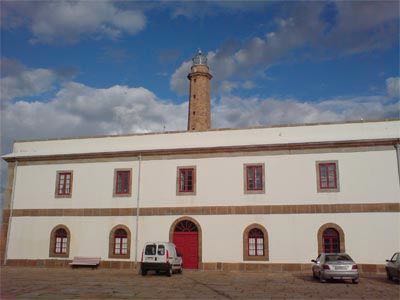
Cabo Villano seen from NE
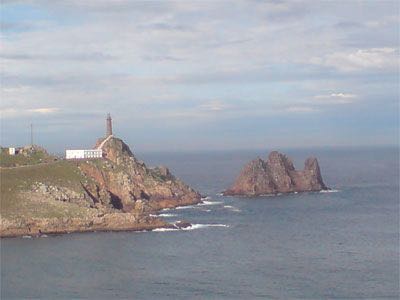
A small lighthouse was established on this site in 1854. The wreck of the "Serpent" (of which more later) in 1890 accelerated a project to build a larger lighthouse and in 1896 the new Cabo Villano lighthouse became the first in Spain to use electricity.
A few miles up the coast there is a cemetry in which some of the crew lost in the wreck of HMS Serpent are buried. More on this wreck here and here.
It is a nasty piece of coast and only two of the crew made it ashore alive.
Site of HMS Serpent wreck showing off lying shoals.
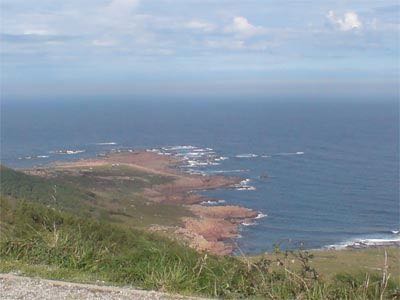
A view of the shoals from sea level.
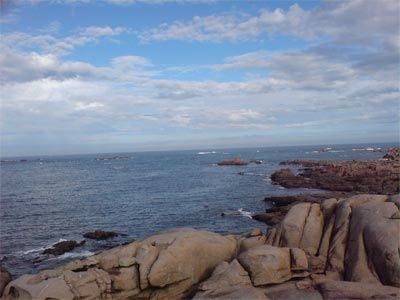
A bit further around the coast I came across I tiny fishing port called Santa Marina. It was reached via a steepnarrow winding road and had recently been rebuilt with EU funding. A fascinating place and frightening to enter from the sea with a narrow rockstrewn approach. It was not on the map.
Next stop was the fishing port of Laxe. It would be interesting to visit here in the spring although it would be necessary to anchor. On the way out of Laxe I came across a strange partially destroyed structure called the Museo Alemand whih had been built by an eccentric German.
Museo de Aleman
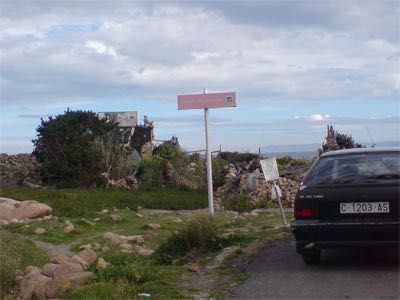
Museo de Aleman
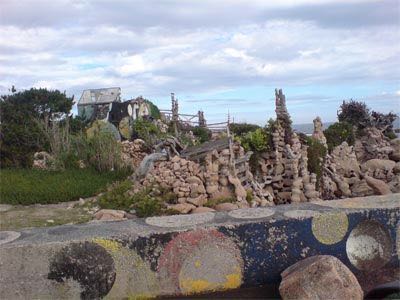
After Laxe it was a long drive around the bay to Punta Roncudo. Another dramatic spot on the Costa del Muerte with a couple of nasty offlying rocks. This coast features many crosses set into rocks in memory of those lost at sea. The tanker "Prestige" broke up at sea off this coast a few years ago dumping 60,000 tonnes of heavy fuel onto the shoreline.
Punta Roncudo lighthouse.
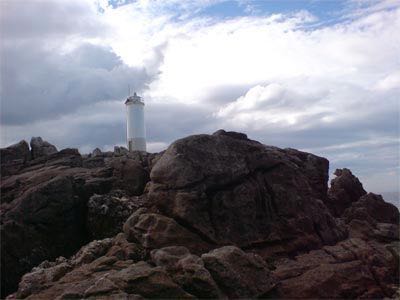
View to seaward with offlying rocks.
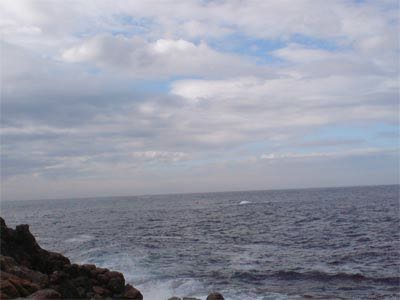
Oil residue from the "Prestige" disaster contrasting with white quartz strip.
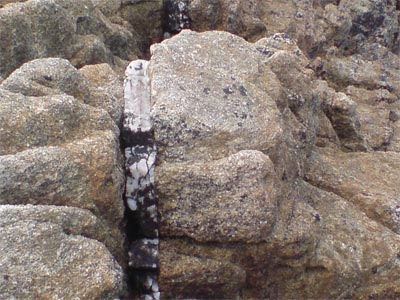
Last stop on the way back to La Coruña is Malpica. Built on a peninsular with a nice beach to the west and a fishing harbour to the east. Not much else of note and it's not really suitable for yachts.
Malpica beach.
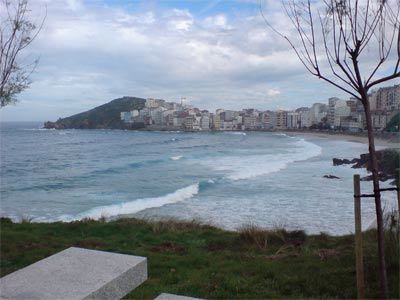
The cape itself is very dramatic with light perched on a highpoint with cliffs plunging into the sea. Immediatly to the west is a tiny vicious looking island.
Lighthouse building with lighthouse behind.

Cabo Villano seen from NE

A small lighthouse was established on this site in 1854. The wreck of the "Serpent" (of which more later) in 1890 accelerated a project to build a larger lighthouse and in 1896 the new Cabo Villano lighthouse became the first in Spain to use electricity.
A few miles up the coast there is a cemetry in which some of the crew lost in the wreck of HMS Serpent are buried. More on this wreck here and here.
It is a nasty piece of coast and only two of the crew made it ashore alive.
Site of HMS Serpent wreck showing off lying shoals.

A view of the shoals from sea level.

A bit further around the coast I came across I tiny fishing port called Santa Marina. It was reached via a steepnarrow winding road and had recently been rebuilt with EU funding. A fascinating place and frightening to enter from the sea with a narrow rockstrewn approach. It was not on the map.
Next stop was the fishing port of Laxe. It would be interesting to visit here in the spring although it would be necessary to anchor. On the way out of Laxe I came across a strange partially destroyed structure called the Museo Alemand whih had been built by an eccentric German.
Museo de Aleman

Museo de Aleman

After Laxe it was a long drive around the bay to Punta Roncudo. Another dramatic spot on the Costa del Muerte with a couple of nasty offlying rocks. This coast features many crosses set into rocks in memory of those lost at sea. The tanker "Prestige" broke up at sea off this coast a few years ago dumping 60,000 tonnes of heavy fuel onto the shoreline.
Punta Roncudo lighthouse.

View to seaward with offlying rocks.

Oil residue from the "Prestige" disaster contrasting with white quartz strip.

Last stop on the way back to La Coruña is Malpica. Built on a peninsular with a nice beach to the west and a fishing harbour to the east. Not much else of note and it's not really suitable for yachts.
Malpica beach.

First stop today is Cabo Villano which was the first land sighted when I crossed from Plymouth to Lisbon some years ago. The area is a bit more built up than Finisterre with a wind farm and surprisingly a Stolt fish farm tucked away on the coast just to the south of the cape.
The cape itself is very dramatic with light perched on a highpoint with cliffs plunging into the sea. Immediately to the west is a tiny vicious looking island.
Lighthouse building with lighthouse behind.

Cabo Villano seen from NE

A small lighthouse was established on this site in 1854. The wreck of the "Serpent" (of which more later) in 1890 accelerated a project to build a larger lighthouse and in 1896 the new Cabo Villano lighthouse became the first in Spain to use electricity.
A few miles up the coast there is a cemetry in which some of the crew lost in the wreck of HMS Serpent are buried. More on this wreck here and here.
It is a nasty piece of coast and only two of the crew made it ashore alive.
Site of HMS Serpent wreck showing off lying shoals.

A view of the shoals from sea level.

A bit further around the coast I came across I tiny fishing port called Santa Marina. It was reached via a steepnarrow winding road and had recently been rebuilt with EU funding. A fascinating place and frightening to enter from the sea with a narrow rockstrewn approach. It was not on the map.
Next stop was the fishing port of Laxe. It would be interesting to visit here in the spring although it would be necessary to anchor. On the way out of Laxe I came across a strange partially destroyed structure called the Museo Alemand which had been built by an eccentric German.
Museo de Aleman

Museo de Aleman

After Laxe it was a long drive around the bay to Punta Roncudo. Another dramatic spot on the Costa del Muerte with a couple of nasty offlying rocks. This coast features many crosses set into rocks in memory of those lost at sea. The tanker "Prestige" broke up at sea off this coast a few years ago dumping 60,000 tonnes of heavy fuel onto the shoreline.
Punta Roncudo lighthouse.

View to seaward with offlying rocks.

Oil residue from the "Prestige" disaster contrasting with white quartz strip.

Last stop on the way back to La Coruña is Malpica. Built on a peninsular with a nice beach to the west and a fishing harbour to the east. Not much else of note and it's not really suitable for yachts.
Malpica beach.

The cape itself is very dramatic with light perched on a highpoint with cliffs plunging into the sea. Immediately to the west is a tiny vicious looking island.
Lighthouse building with lighthouse behind.

Cabo Villano seen from NE

A small lighthouse was established on this site in 1854. The wreck of the "Serpent" (of which more later) in 1890 accelerated a project to build a larger lighthouse and in 1896 the new Cabo Villano lighthouse became the first in Spain to use electricity.
A few miles up the coast there is a cemetry in which some of the crew lost in the wreck of HMS Serpent are buried. More on this wreck here and here.
It is a nasty piece of coast and only two of the crew made it ashore alive.
Site of HMS Serpent wreck showing off lying shoals.

A view of the shoals from sea level.

A bit further around the coast I came across I tiny fishing port called Santa Marina. It was reached via a steepnarrow winding road and had recently been rebuilt with EU funding. A fascinating place and frightening to enter from the sea with a narrow rockstrewn approach. It was not on the map.
Next stop was the fishing port of Laxe. It would be interesting to visit here in the spring although it would be necessary to anchor. On the way out of Laxe I came across a strange partially destroyed structure called the Museo Alemand which had been built by an eccentric German.
Museo de Aleman

Museo de Aleman

After Laxe it was a long drive around the bay to Punta Roncudo. Another dramatic spot on the Costa del Muerte with a couple of nasty offlying rocks. This coast features many crosses set into rocks in memory of those lost at sea. The tanker "Prestige" broke up at sea off this coast a few years ago dumping 60,000 tonnes of heavy fuel onto the shoreline.
Punta Roncudo lighthouse.

View to seaward with offlying rocks.

Oil residue from the "Prestige" disaster contrasting with white quartz strip.

Last stop on the way back to La Coruña is Malpica. Built on a peninsular with a nice beach to the west and a fishing harbour to the east. Not much else of note and it's not really suitable for yachts.
Malpica beach.

